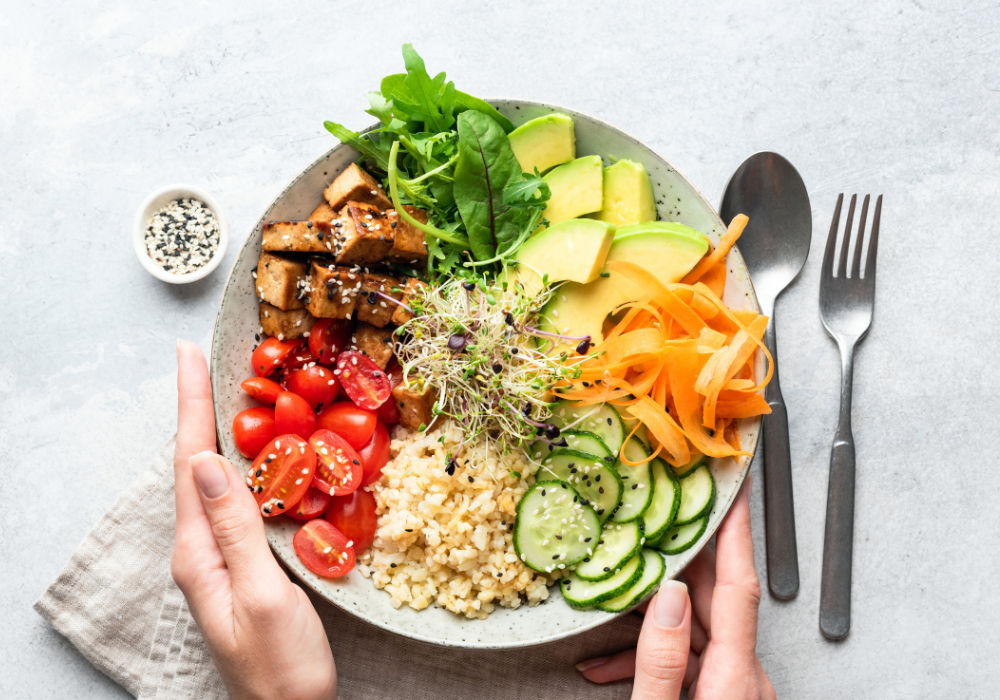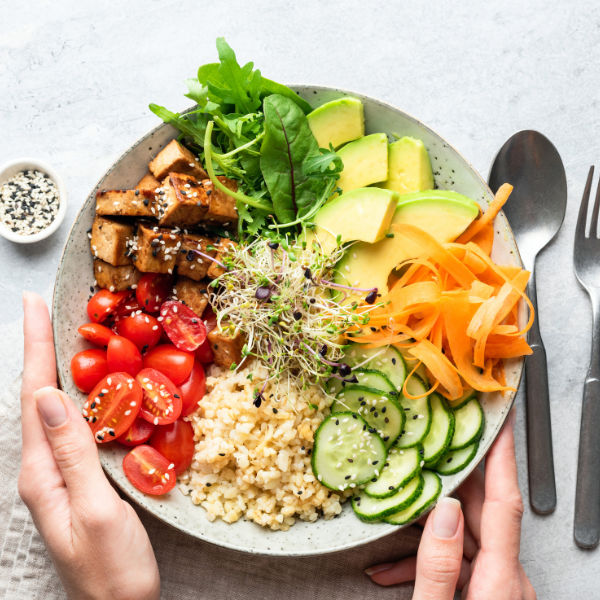Balancing your blood sugar, staying fuller for longer, maintaining consistent energy levels… All of this can be accomplished by creating and eating meals that are nutritionally balanced.
But what is “balanced”, and how do you put together a balanced meal without meticulously tracking macros?
That’s what we’re tackling today. Keep reading to learn a simple method for creating nutritionally balanced meals, no matter the specifics of what you’re eating.

On a plant-based diet, it can be confusing to figure out what exactly to eat. Assembling meals without meat or dairy can be challenging at first, and all too often, we end up putting together meals that are all carbs, or mostly fat… In a word, not nutritionally balanced!
So what’s so bad about eating nutritionally imbalanced meals?
- The biggest reason is that meals that contain mostly one macronutrient (for example, an all-carb meal) wreak havoc on our blood sugar. On the other hand, meals that contain complex carbohydrates, high-quality protein, healthy fats, and fiber help regulate our blood sugar. This means that instead of drastic spikes and dips, we get slow rises and falls, more like rolling waves than craggy mountains. Regulating our blood sugar means we’ll be able to avoid the dreaded 3 PM energy slump and retain a healthy insulin response.
- The second reason to avoid nutritionally imbalanced meals is that they make it harder to meet our daily nutrient needs. If we eat a breakfast composed of all carbohydrates (ie just fruit), we’re putting additional pressure on our remaining meals that day to get enough protein and fat. See how this could easily lead to nutrient insufficiencies?
- And finally, the third reason is that nutritionally balanced meals simply taste better! Meals with a variety of colors, tastes, and textures generally contain a better balance of carbs, fat, and protein. Taste and health really do go hand in hand here!
So, have I convinced you that eating nutritionally balanced meals is the way to go?
Now onto the best part. There’s a simple method you can use to plan out and assemble nutritionally balanced meals. This method works for any type of meal or snack, at any time of day. The cherry on top? The method doesn’t require you to track calories, measure food quantities, or any other traditional form of nutrient tracking. Honestly, it couldn’t be simpler and anyone can use it.
So, let’s dive in.
Using the Plate Method for creating nutritionally balanced meals
When planning a meal, think of the components of your meal in terms of food groups or macronutrients. These two methods are essentially two paths to the same result, so choose whichever makes more sense and comes more naturally to you.
Then, when you’re assembling your meal, make sure to include the following:
- Complex carbs: whole grains or starchy root veg (or their products like brown rice pasta or whole wheat bread)
- Plant-based protein: beans, lentils, peas, tofu, tempeh
- Healthy fats: avocado, nuts, seeds, nut/seed butter
- Abundant fruits and/or veggies
While produce falls into macronutrient buckets, it plays the equally important role of providing micronutrients to your meal via vitamins and minerals.
There’s an easy visual tool to help you create these nutritionally balanced meals called The Plate Method.
The method is adapted from government food guidelines like Canada’s Updated Food Guide and the USA’s MyPlate with modifications to adapt it for the plant-based diet.
Using the Plate Method couldn’t be simpler. To follow this method, you want to envision your plate sectioned into three parts and add the appropriate amount of each type of food.
- ½ veggies/fruit
- ¼ plant-based protein
- ¼ whole grains/starchy veg
- + healthy fats

While healthy fats sit off to the side in the diagram, there’s no need to actually separate them out. Fill half your plate with fruits and/or veggies, a quarter with your protein of choice, and the remaining quarter with complex carbohydrates, then add your healthy fat. Once you have the proportions down, you don’t need to keep the different macros separated on your plate.
If you like this concept and want to try it out asap, check out this corresponding blog post on my go-to lunch formula that uses The Plate Method to create quick and nourishing lunches.
Some meals simply won’t align with the Plate Method and that’s okay! If one meal isn’t fully balanced, you’ll have another opportunity to account for that in the next meal. If your breakfast or lunch is low in protein, for example, eat a protein-rich snack later in the day. As long as you’re eating a variety of foods while roughly following the Plate Method at most meals, chances are your nutrients will balance out over the course of the week.
So use this method as a general guideline. This will keep it a useful tool that allows you freedom instead of one that causes restriction.
And that’s it. Told you it was simple! But it goes beyond simple. Let’s talk about why it’s also so effective.
Here’s why I recommend The Plate Method as the best tool for creating balanced meals:
The plate method is a simple visual guide that shows the portion of each food group needed to meet our nutrient needs.
If we regularly include all components of the Plate Method in meals and rotate the types of foods in each category, we’ll likely achieve the macro and micronutrients we need for optimal health and well-being.
This method is so powerful because it takes numbers, calorie tracking, and servings out of the picture, and allows the planning and plating of meals to become more effortless.
Also, the model takes the shape of a plate, but in reality, this method works for any type of meal whether it’s on a plate, in a bowl, a sandwich, or a wrap. And, it works just as well for meals as it does for snacks.
Now before you rush off to try the Plate Method for yourself, remember this:
The purpose of the plate method is not to meticulously organize our food in an exact orientation, or become hyper-focused on specific proportions for all of our meals.
You don’t want a helpful tool to become a prison for you and be the cause of restriction.
As I’m constantly teaching here, it’s what we do consistently, on a daily basis, that matters in the long run. So don’t let this method, or any other, rule your life. Use it when it’s useful to you, and leave it when it isn’t.
Happy meal assembling!
If you found this blog post helpful and want to dive deeper into this topic, check out this wonderful article by plant-based dietician Sadia Badiei, where I first learned about the Plate Method.
